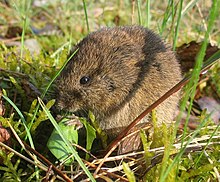Common vole
Appearance
This article includes a list of general references, but it lacks sufficient corresponding inline citations. (May 2019) |
| Common vole | |
|---|---|

| |
| Scientific classification | |
| Domain: | Eukaryota |
| Kingdom: | Animalia |
| Phylum: | Chordata |
| Class: | Mammalia |
| Order: | Rodentia |
| Family: | Cricetidae |
| Subfamily: | Arvicolinae |
| Genus: | Microtus |
| Subgenus: | Microtus |
| Species: | M. arvalis
|
| Binomial name | |
| Microtus arvalis (Pallas, 1778)
| |

| |
| Common vole distribution | |
| Synonyms[2] | |
|
Microtus obscurus (Eversmann, 1841) | |
The common vole (Microtus arvalis) is a European rodent.
Distribution and habitat
The common vole is hardly restricted in means of distribution and habitat and inhabits large areas of
grass
, but it also feeds on many agricultural crops (within secondary habitats) and here its reproduction is faster than in primary habitats.
Reproduction, demography, and predation
After
boar
.
Territories and nests
M. arvalis maintains aboveground runways, which expand like a
railway-system through the entire home range. Voles are seldom seen outside these runways, which enable a faster and safer locomotion and easier orientation. The climbing ability of the common vole is very poor. Underground nests are dug 30–40 cm (12–16 in) deep into the ground and are used for food storage, offspring raising, and as a place for rest and sleep. Nests can be shared and defended by up to five females with juveniles that are related in most cases. Females are territorial and an overlap of occupied areas does not occur. Hence, the number of colonies increases with individual number (i.e. population density). As common voles have a polygynous
mating system the males do not maintain territories and move as so-called "floaters" between several females' territories in order to mate as often as possible. They can show overlap in territories. These findings are supported by the different home range sizes of males (1200–1500 m2) and females (300–400 m2) that can decrease in both males and females as population density rises. Another response to population growth is to leave the original habitat and move towards another one. Males predominantly conduct dispersal, being most often caused by the competition for mates.
See also
References
- . Retrieved 11 November 2021.
- ^ "Microtus obscurus". Integrated Taxonomic Information System.
- Baillie, J. 1996. Microtus obscurus. 2006 IUCN Red List of Threatened Species. Retrieved 9 July 2007.
- Musser, G. G. and M. D. Carleton. 2005. Superfamily Muroidea. pp. 894–1531 in Mammal Species of the World a Taxonomic and Geographic Reference. D. E. Wilson and D. M. Reeder eds. Johns Hopkins University Press, Baltimore.
- Niethammer, J. and Krapp, F. 1982. Handbuch der Säugetiere Mitteleuropas. – Akademische Verlagsgesellschaft Wiesbaden
External links
![]() Media related to Microtus arvalis at Wikimedia Commons
Media related to Microtus arvalis at Wikimedia Commons

